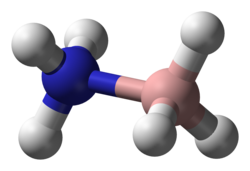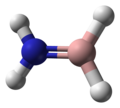 | |
 | |
| Names | |
|---|---|
| IUPAC name Ammoniotrihydroborate | |
| Other names | |
| Identifiers | |
3D model (JSmol) | |
| ChemSpider | |
| ECHA InfoCard | 100.170.890 |
| EC Number |
|
PubChem CID | |
| UNII | |
CompTox Dashboard (EPA) | |
| |
| |
| Properties | |
| H3NBH3 | |
| Molar mass | 30.87 g·mol−1 |
| Appearance | Colorless crystals |
| Density | 0.78 g/cm3 |
| Melting point | 104 °C (219 °F; 377 K) |
| Structure | |
| I4mm, tetragonal | |
| Tetragonal at B and N | |
| Tetrahedral at B and N | |
| 5.2 D | |
| Hazards [4] | |
| GHS labelling: | |
  | |
| Danger | |
| H228, H302, H315, H319, H332, H335 | |
| P210, P240, P241, P261, P264, P264+P265, P270, P271, P280, P301+P317, P302+P352, P304+P340, P305+P351+P338, P317, P319, P321, P330, P332+P317, P337+P317, P362+P364, P370+P378, P403+P233, P405, P501 | |
| Related compounds | |
Related compounds | |
Except where otherwise noted, data are given for materials in their standard state (at 25 °C [77 °F], 100 kPa). | |
Ammonia borane (also systematically named ammoniotrihydroborate[ citation needed ]), also called borazane, is the chemical compound with the formula H3NBH3. The colourless or white solid is the simplest molecular boron-nitrogen-hydride compound. It has attracted attention as a source for hydrogen fuel, but is otherwise primarily of academic interest.




